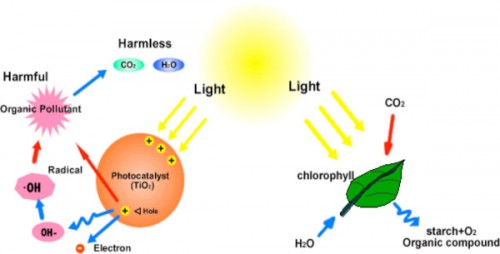Antibacterial Tiles that Clean and Sanitize Themselves
Image courtesy babylovingmama.com
Now imagine restroom tiles that not only contend with gravity and wear and tear, but that also play an active part in improving the quality of the environment. Stonepeak Ceramics in collaboration with Fiandre have developed Active Ceramics (antibacterial, antifungal, self-cleaning tiles that mitigate indoor air pollution). I’m not making this up: production plants for ActiveTM Clean Air & Antibacterial Ceramic have already been completed both in Tennessee and in Modena, Italy.
Image courtesy www.kitchenisms.com – note: tiles by Heather Knight of Element Clay Studio
Active Clean Air & Antibacterial Ceramic™ is a material obtained using a new methodology applied to porcelain tiles, which exploits the principle of photocatalysis, activated by semiconductor titanium dioxide (TiO2). Photocatalysis is a way of using light (usually sunlight) to drive a “useful” chemical reaction. This could involve splitting water into oxygen and hydrogen, but it might also mean turning organic chemicals into water and carbon dioxide (Calvinus).
Image courtesy calvinus.wordpress.com
Photocatalysis is nothing more than the acceleration of oxidation processes that are already present in nature, and helps to speed up the breakdown of the polluting agents present in the environment. According to Fiandre, the process prevents the build-up and spread of bacteria on tiles because it is “carrying out a self-cleaning action” (Source: Press Release, Fiandre).
Image courtesy Millron
But before we all run out and retile our bathrooms, I’d like to present a caveat or two. It should be noted that for photocatalysis to occur, “the light hitting the tiles must have enough energy to overcome barriers in the semiconductor. For titanium dioxide, this means the light has to be particularly high in energy – it can only use ultraviolet light. Given that this is only around 4% of natural sunlight, this is a problem if photocatalysis is to be a useful process. This is especially the case for indoor applications where room lights tend to have negligible ultraviolet light” (Calvinus). While I’m excited by the idea that porcelain tiles could have an impact on indoor air quality, I noticed several Barry Bonds style asterisks on the product information for Active Ceramics that stipulated the results applied only for exterior applications. But hey, whoever said a ceiling was a requirement in a public restroom?
Even if titanium dioxide-based photocatalysis is a less robust bacteria-killing, air-filtering process than we’d like, the notion that we ought to call upon our materials to work harder and do more to reduce pollution is not without value. And if only a small amount of self-cleaning and bacteria termination is occuring, I’d say that’s better than nothing! What do you think? Hit the comments.
I’m filing Antibacterial tiles in the EARTH category.
Cited:
Press Release, Fiandre. Milano. 28 September 2010.
Calvinus. “Photocatalysis: Buy my Snake Oil” Post Tenebras Lux. 09/30/09. Accessed 11/05/10. URL.



















Even if the standard lighting within the restroom isn’t intense enough to create the reaction, wouldn’t the use of a handheld light wand or a flash of light a la \Men in Black\ be easier than scrubbing?
[…] dioxide. Bonding this chemical to various materials is a growing trend in green building (read about ceramic tiles coated with TiO2 here) because it’s thought to break down organic matter, SOx (sulphur oxides), and NOx (nitrogen […]
Leave a Wordpress Comment:
Ads
Watch ARCHITERIALS Videos on vimeo
Like on Facebook
Twitter
Flickr
Hit Counter
Ads
Blogs
Green
Journals/Publications
Materials
Network/News
Offices/People
Resources
Science
Pages
Archive
RSS and Email Subscriptions
Tag Cloud
3D 3D printer AB FAB academic acid acrylic actuated matter adaptive adhesive adsorption aerogel air air conditioning alloy aluminum amnh antibacterial antifungal ants april fool's architecture architecture robot artificial skin autonomous aviation awesome bacteria bamboo bananas beer bench bend bending biennale biocomputing biodegradable biodegradeable biomaterials biomimetics biomimicry biominerals biopolymer birds blast blast-resistant block blocks blogs Bloom Box brazil brick bubbles bucky bulk metallic glass butterfly calera canvas carbon carbon fiber carbon nanotubes carpet cars ceiling cellulose cement ceramic chain link chair charcoal charlie sheen chemicals chiller clay cloth cloud cmu coils color color-changing communication compound computer concrete condensation conducting conductive context cool coral cracks crystal cyborg demakersvan design digifab dirt disaster dna dror drywall dutch dynamic EAP earth ecocradle ecolect e coli ecology ecoresin ecovative elastic electric electricity electrochromic electroluminescent electronic energy energy recovery environment evaporative cooling experiment fabric fabrication facade fiber fiberglass fiber optic fiber optics fibers film FIRE flexible flickr fly ash foam fungus furniture garbage gel geodesic dome geometry gfrp gilgamesh glass glass fiber glow glue gold graphene green greensulate gsapp gypsum hard heat heavy heidi klum helix hemp hexagon hidden high performance hive honeybee humidity ice India ink insulation interference Internet inventables invisible invisible ink jello jellyfish just add water kevlar kinetic korea lace lamboo laser lattice leaves LED leed LEGO light light emitting light transmitting liquid lo mein london Loop.pH machines magic magnetic marine material materials meatball melting memory metabolic engineering METAL metal panel metamaterial micro microsensor microtools military milk MIT moisture multi-layer mushrooms mycelium nano nanogel nanotech nanotubes NASA new noise non-metallic oil OLED OMA ostrich oysters packaging paint panel panels paper paperfoam paraffin wax particles particulates petroleum phase change phosphorescent pink PLA plastic platinum pm-10 poetry pollution polymer polymers porcelain power precast printed printing protein public quadror radiant rain rammed earth reclaimed recycled reflective refracting Rem Koolhaas resin robot robotics roof rubber rugged sand sealant sealer search segmented self-healing sensor shape memory silica silicon silk skin skittles slats smog soft solar solar cell solar cells solar paint solid solid state lighting sound spider spider glue spray stabilized sand stone stretch stretchable strong structural structure studio dror sun sunglasses super supercritical sustainable switzerland tags tape technology TED tensile TEXAS textile textiles texture thermal thermochromatic thin thin film thread tiger stone tile tiles timber tio2 tires toaster tokujin yoshioka touch touch-sensitive toxic transparent t shirts tulip ultra-thin university of akron university of connecticut upcycling virus voc wall wallpaper WATER web wet whale wires WOOD woodwool wool workshop
WP Cumulus Flash tag cloud by Roy Tanck and Luke Morton requires Flash Player 9 or better.
Recent Comments
Ads